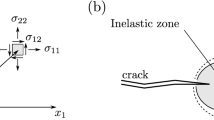Abstract
For an anti-plane problem, the differential operator is self-adjoint and the corresponding eigenfunctions belong to the Hilbert space. The orthogonal property between eigenfunctions (or between the derivatives of eigenfunctions) of anti-plane problem is exploited. We developed for the first time two sets of radius-independent orthogonal integrals for extraction of stress intensity factors (SIFs), so any order SIF can be extracted based on a certain known solution of displacement (an analytic result or a numerical result). Many numerical examples based on the finite element method of lines (FEMOL) show that the present method is very powerful and efficient.
Similar content being viewed by others
References
Williams M. L., Stress singularities resulting from various boundary conditions in angular corners of plates in tension. J. Appl. Mech., 1952, 14: 526–528.
Williams M. L., On the stress distribution at the base of a stationary crack. J. Appl. Mech. 1957, 24: 109–114.
Williams M. L., Surface stress singularities resulting from various boundary conditions in angular coners of plates under bending. Proc. First U. S. Nat, Congress of Appl Mech., 1950: 325–329.
Hartranft R. J. and Sih G. C., The use of eigenfunction expansions in the general solution of three-dimensional crack problems. Journal of Mathematics and Mechanics, 1969, 19(2): 123–138.
Liu Chuntu, Stress and deformation near the crack tip for bending plate. Acta Mechanica Solida Sinica, 1983, 3: 441–448 (in Chinese)
Gross B., Srawley J. E. and Brown W. F., Stress intensity factors for a single-edge-notch tension specimen by boundary collocation, NASA TN D-2395, 1964.
Kobayashi A. S., Cherepy R. B. and Kinsel W. C., A numerical procedure for estimating the stress intensity factor of a crack in a finite plate. Journal of Basic Engineering, 1964, 86: 681–684.
Gross B. and Mendelson A., Plane elastic analysis of V-notched plates. Int. J. Fract. Mech., 1972, 8: 267–276.
Wilson W. K., Numerical method for determining stress intensity factors of an interior crack in a finite plate. Journal of Basic Engineering, 1971: 685–690.
Carpenter W. C., A collocation procedure for determining fracture mechanics parameters at a corner. International Journal of Fracture, 1984, 24: 255–266.
Rzasnicki W., Mendelson A and Albers L. U., Application of boundary integral method to elastic analysis of V-notched beams. NASA TN-F-7424, 1973.
Rzasnicki W. and Mendelson A, Application of boundary integral method to elastoplastic analysis of V-notched beams. International Journal of Fracture, 1975, 11: 329–342.
Stern M., Becker E. B. and Dunham R. S., A contour integral computation of mixed-mode stress intensity factors. International Journal of Fracture, 1976, 12(3): 359–368.
Mohan Lal Soni and M. Stern, On the computation of stress intensity factors in composite media using a contour integral method. Int. J. Fract., 1976, 12(3): 331–344.
Long Yuqiu, Zhi Bingchen, Kuang Wenqi, Shan Jian, Sub-region mixed finite element method for the calculation of stress intensity factor. Sinica Mechanica, 1982, 4: 341–353 (in Chinese).
Long Yuqiu, Zhi Bingchen and Yuan Si, Sub-region, sub-item and sub-layer generalized variational principles in elasticity//Proceedings of International Conference on Finite Element Methods, (ed. He Guangqian and Y. K. Cheung), Shanghai, 1982: 607–609.
Long Yuqiu and Zhao Yiqiang, Technical note: Calculation of stress intensity factors in plane problems by the sub-region mixed finite element method. Adv. Eng. Software, 1985, 7(1): 32–35.
Xu Yongjun, Yuan Si, Complete eigensolutions for plane notches with multi-materials by the imbedding method. International Journal of Fracture, 1996, 81: 373–381.
Xu Yongjun, Yuan Si, Complete eigensolutions for anti-plane notches with multi-materials by super-inverse iteration. Acta Mechanica Solida Sinica, 1997, 10(2): 157–166.
Xu Yongjun, Yuan Si, Liu Chuntu, The progress on complete engen-solution of two dimensional notch problems. Advances in mechanics, 2000, 30(2): 216–226 (in Chinese).
Xu Yongjun, Yuan Si, Liu Chuntu, Possible multiple roots for fracture problems. Acta Mechanica Sinica, 1999, 31(5): 618–624 (in Chinese).
Xu Yongjun, Eigenproblem in fracture mechanics for reissner plate. Acta Mechanica Solida Sinica, 2004, 25(2): 225–228 (in Chinese).
Xu Yongjun, Liu Chuntu, The eigenvalues and eigenfunctions in shallow shell fracture analysis. Acta Mechanica Solida Sinica, 2000, 21(3): 256–260 (in Chinese).
Yuan Si, A new semi-discrete method—the finite element method of lines//Proceedings of 1st National Conference on Analytical and Numerical Combined Methods, Hunan, 1990: 132–136 (in Chinese).
Yuan Si and Gao Jianling, A new computational tool in structural analysis: the finite element method of lines (FEMOL)//Proceedings of International Conference on EPMESC, Macau, 3 (Aug. 1–3, 1990): 517–526.
Yuan Si, The finite element method of lines. Chinese Journal of Numerical Mathematics and Applications, 1993, 15(1): 45–59.
Yuan Si, The Finite Element Method of Lines: Theory and Applications. Beijing-New York: Science Press, 1993.
Ascher U., Christiansen J. and Russell R. D., Collocation software for boundary-value ODEs. ACM Transaction of Mathematical Software, 1981, 7(2): 209–222.
Ascher U., Christiansen J. and Russell R. D., Algorithm 569, COLSYS: collocation software for boundary-value ODEs [D2]. ACM Transaction of Mathematical Software, 1981, 7(2): 223–229.
Yuan Si, A general-purpose FEMOL program—FEMOL92. Computational Structural Mechanics and Applications, 1993, 10(1): 118–122 (in Chinese).
Yuan Si, The finite element method of lines: theory and applications. Beijing-New York: Science Press, 1993.
Erwin Kreyszig, Introductory Functional Analysis with Application. JOHN WILEY & SONS, 1978.
Xanthis L. S., A pseudo-ODE modeling trick for the direct method of lines computation of important fracture mechanics parameters. ACM SIGNUM Newsletter, 1986, 21(1–2).
Author information
Authors and Affiliations
Additional information
Project supported by the National Natural Science Foundation of China (Nos. 59525813 and 19872066).
Rights and permissions
About this article
Cite this article
Xu, Y., Yuan, S. Stress intensity factors calculation in anti-plane fracture problem by orthogonal integral extraction method based on FEMOL. Acta Mech. Solida Sin. 20, 87–94 (2007). https://doi.org/10.1007/s10338-007-0710-4
Received:
Revised:
Published:
Issue Date:
DOI: https://doi.org/10.1007/s10338-007-0710-4




